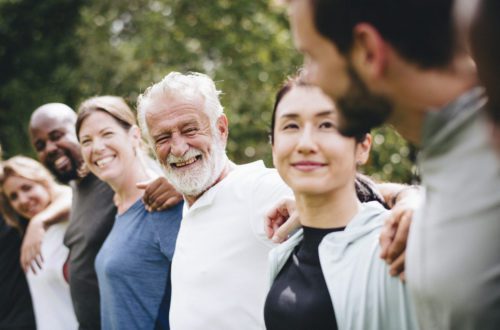
Letting Go
A major principle when doing Awareness Through Movement® lessons is to “do less”. Interestingly, it isn’t so easy.
With each lesson, participants are instructed to move easily, only do what is comfortable, and make the movements simple.
Yet, so often, following those directions can be challenging. As a practitioner, I have learned strategies to make it easier for students, but still, you may wonder why is it challenging to begin with?
Early Learning
As youngsters, we use our senses to explore our environment. We learn. We grow. We develop. Part of that development is to work to get our needs met. If one way doesn’t work, we may try another until we get satisfied. Think food, comfort, security. However, our attempts may be misunderstood or neglected. After all, we are talking about humans here.
In the process, we experience too much, too little or just enough. We repeat, learn, forget. Patterns emerge. In our continual attempt to get our needs met, we develop strategies and eventually habits. Since we are moving within the arc of time and with limited attention span and memory, we don’t always know how or when patterns have laid down deeply, embedded synapses within our nervous system.
An Example
I was practicing tennis serves on outdoor courts recently while 3 youngsters played a couple courts away. Their mom gave them lots of space to be kids as she walked two dogs around the nearby field. I chuckled to myself, listening to them jockeying to win, yelling, “You cheated”, “No, you can’t do that”, “If you did that, I can do that.” They were unfiltered, all in the name of “winning”, to be the best, to make a mark for themselves.
They knew well how to keep score, but had to work, shift and adjust themselves to make the moves that it takes to keep the ball in the lines.
With limited skill, we create strategies to cope with what it is that we want, but don’t yet know how to get.
Aren’t we all trying to win at something or another? To do our best? To belong? Keeping score of who is better and who is not?
As Adults
This adjustment to situations in our lives creates motor patterns in our movements. The motor patterns that carry out the actions that we do to fulfill our needs and wants.
The actions that we do regularly–walking, getting in and out of a car, getting dressed and undressed become so automatic that we can plan our day or have an imaginary conversation with ourselves or another person as we do those things because we don’t need the bandwidth to do the action.
The things that demand more of our attention require that we focus more astutely–driving a car on a winding, narrow road; going up or down steep steps with our hands full or presenting an idea to a large group of people. In the process we may try too hard by over shooting or over efforting or we don’t try hard enough-avoiding, anticipating, or blaming in the process. In these situations, anything unexpected that happens can be disastrous. Sometimes we get lucky, sometimes we don’t.
The Relationship to Letting Go
When we over effort or over strive, we create tension. Where does that tension live? In the mind, in the nervous system, and in the way that we move and act, meaning muscles have something to do with it.
Muscle tension gets our attention–headaches, tightness, achiness, and pain.
One technique to deal with tension is to “Let Go”. Googling it, one finds a variety of techniques in terms of psychology dealing with anger, relationships, worries and more.
Remember the counting to 10 advice? I tried it a few times, but I didn’t know what was supposed to happen when I was done. I still went back to the thing that bugged me to begin with. It might have quieted me, but it didn’t change how I thought or believed.
There is also, “Let go and let God.” I first learned that phrase in 12 step recovery programs. I followed that for a while and then I realized that there was something deeper that I wanted and that was connection. Deep connection wasn’t happening for me in 12 step programs and so I moved on.
Feldenkrais Method
Training and practicing in the Feldenkrais Method has given me the opportunity to explore options, to be quiet enough with myself so as to soften the automatic pulls of habit.
Doing Awareness Through Movement® lessons didn’t automatically help me to “let go”, but it gave me the opportunity to slow down, to notice how I relate to feeling challenged, confused or uncomfortable and what I can do about it. To choose to continue, pause, reflect, imagine, or think.
We will never “let go” of all habits. Nor will we want to. Having habits is important, they help us to be efficient and predictable. The problem comes in when our habits interfere with wanting something better or different in our lives.
Next Time
So the next time you find yourself in a situation that you aren’t satisfied with, notice. What are you doing? How are you doing it? Go deep into sensing the quality of movement itself. Is there something new? What is familiar? What is repetitive?
We will continually find ourselves caught in the trap of our doing–our habits, throughout our lives. Upgrading our sensory-motor response to situations alters our deeply engrained habits. No matter how much self-talk or psychological strategies that we use to cope, to “let go”, we won’t make lasting change until we understand how we move and what we keep doing that is a part of the tension loop; until we recognize how we do what we do and how we want to do differently, how we want to feel differently, and how we want to think differently.
Moshe Feldenkrais said, “What I’m after isn’t flexible bodies, but flexible minds and to restore each person to their human dignity.”
What upgrade do you want in order to “Let Go”–to feel better or move easier? What small body adjustment can you make to begin the change?




